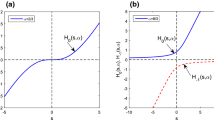Abstract
A new approach to the modeling of drug disposition is described. Disposition is regarded as the result of repetitive passes of the drug around the circulation. Mathematical analysis of experimental blood concentration data yields an expression describing the kinetics of a single pass through the tissues. In physicochemical terms the single-pass behavior depends to a large extent on the interaction of the drug with individual tissues, which greatly simplifies interpretation. The method may reveal features of disposition not apparent from experimental blood concentration data.
Similar content being viewed by others
References
K. L. Zierler. Circulation times and the theory of indicator-dilution methods for determining blood flow and volume. InHandbook of Physiology, Section 2:Circulation, Vol. I, American Physiological Society, Washington, D.C., 1962, pp. 585–615.
C. Waterhouse and J. Keilson. Transfer times across the human body.Bull. Math. Biophys. 34:33–44 (1972).
D. J. Cutler. Linear systems analysis in pharmacokinetics.J. Pharmacokin. Biopharm. 6:265–282 (1978).
L. I. Harrison and M. Gibaldi. Physiologically based pharmacokinetic model for digoxin disposition in dogs and its preliminary application to humans.J. Pharm. Sci. 66:1679–1683 (1977).
R. V. Churchill.Operational Mathematics, 2nd ed., International Student Edition, McGraw-Hill, Kogakusha, 1958, p. 58.
J. G. Wagner.Biopharmaceutics and Relevant Pharmacokinetics, 1st ed., Drag Intelligence Publications, Hamilton, Ill., p. 261.
J. Kampmann and L. Skovsted. The pharmacokinetics of propylthiouracil.Acta Pharmacol. Toxicol. 35:361–369 (1974).
D. D. Breimer, C. Honhoff, W. Zilly, E. Richter, and J. M. van Rossum. Pharmacokinetics of hexobarbital in man after intravenous infusion.J. Pharmacokin. Biopharm. 3:1–11 (1975).
J. R. Koup, D. J. Greenblatt, W. J. Jusko, T. W. Smith, and J. Koch-Weser. Pharmacokinetics of digoxin in normal subjects after intravenous bolus and infusion doses.J. Pharmacokin. Biopharm. 3:181–192 (1975).
J. M. van Rossum. Significance of pharmacokinetics for drug design and the planning of dosage regimens. In E. J. Ariens (ed.),Drug Design, Vol. I, Academic Press, New York, 1971, pp. 469–521.
S. Riegelman, J. C. K. Loo, and M. Rowland. Shortcomings in pharmacokinetic analysis by conceiving the body to exhibit properties of a single compartment.J. Pharm. Sci. 57:117–123 (1968).
Author information
Authors and Affiliations
Rights and permissions
About this article
Cite this article
Cutler, D.J. A linear recirculation model for drug disposition. Journal of Pharmacokinetics and Biopharmaceutics 7, 101–116 (1979). https://doi.org/10.1007/BF01059445
Received:
Revised:
Published:
Issue Date:
DOI: https://doi.org/10.1007/BF01059445




